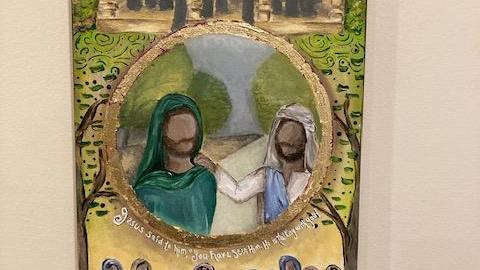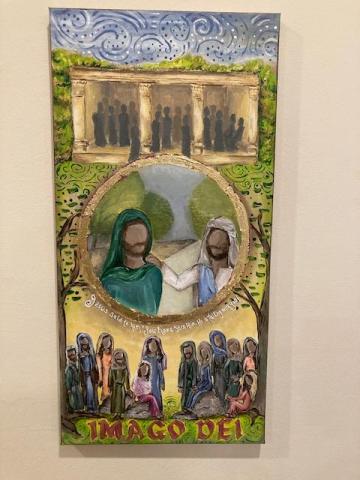Disability Concerns, Faith Nurture
Recognizing the Image of God in Every Body, Story 2: Man Born Blind
May 24, 2024
0 comments
46 views

This is one of four stories of disability within the Bible that have historically been portrayed in a way that diminishes the disability story and the value of seeing God’s image within that person.However, an in-depth analysis reveals that the story is less about offering a cure to a person with a disability and more about healing relationships and restoring a sense of community and well-being. Let’s reimagine a new way of visualizing these stories through art.
To access the main article exploring Imago Dei (“image of God”) that presents an in-depth look at how we have perpetuated negative stereotypes through Biblical narrative, please look here: Recognizing the Image of God in Every Body. The rest of the series is accessible in the following posts: Story 1, Story 3, Story 4.
This story is one of several examples of Jesus performing miracles during his ministry. Healing someone born blind was part of the Messianic miracles that Jesus did to reveal to the world that He was the Messiah. Isaiah 29:18 (NLT) states: "In that day the deaf will hear words read from a book, and the blind will see through the gloom and darkness."
However, in the midst of Jesus performing this miracle, his disciples raised a discussion that harkened back to the time of Moses: the question of the relationship between sin and earthly hardship (John 9:2). Why do some people suffer more than others? Does suffering have any relationship to sin? God himself offered these words to Moses (Exodus 33:19): “For I will be gracious to whom I will be gracious, and will show compassion on whom I will show compassion.” Over the ages, rabbis continued to debate the concept of arbitrary suffering and its relationship to sin. Ezekiel adds to the conversation, noting what God shared with him:
The one who sins is the one who will die.The child will not share the guilt of the parent, nor will the parent share the guilt of the child.The righteousness of the righteous will be credited to them, and the wickedness of the wicked will be charged against them (Ezekiel 18:20).
This passage again raises the conversation on whether suffering--in this case, blindness--indicates sin. Jesus immediately rejects that notion, reminding them of his Messianic mission “that the work of God may be displayed in his life” (John 9:3).
What follows is a series of questioning and doubting of Jesus and His power and status by the Pharisees. They question His decision to cure the man on the Sabbath. They question whether He is from God. They question whether the man had truly been blind. They use their position of authority to minimize the man who had just received ultimate healing by banishing him from the synagogue and continuing to claim his sinfulness (John 9:34).
When we reflect on this passage, it is often simplified to the statement of Jesus healing the blind man. But what of the man who gained his sight? He was brought before the Pharisees, who did not believe him. His parents hesitated to respond regarding his disability due to fear. He was thrown out of the synagogue for speaking truth about Jesus’ deity.
Yet, Jesus once again seeks him out. Already having given him the gift of sight, he questions the man on his faith. The man was no longer physically blind but had been thrown out of the synagogue, the central hub of society at the time. He declares his full belief in Jesus, the son of God. Whereas his physical healing is what is typically focused on, is not the true gift his full welcome into the body of faith? In this passage, Jesus exemplifies the message that He is the light of the world and those who do not see this are blind.
Perspective from Cassie Lokker
This immediately reminds me that I was not born blind because of any sin or defect in me.
Although it sometimes doesn’t make sense that I have a disability, I know God is using me to bring His light into the world, despite the fact that my eyes are dimmed or impaired. Even though I have not been physically healed in my lifetime, I imagine that the gift of physical sight and light would be an overwhelming thing to consider. I would hope and pray that if given such a gift, I would respond with boundless gratitude. But the truth is, I’m still blind, and I most likely will remain so throughout the rest of my life. I need to make the best of what I’ve been given and be willing to share His light and love in being sent out to others.
Re-visioning the story
“Jesus is the light of the world” is a statement that is often mentioned in religious circles. Many novelty mugs and wall plaques have this saying on them. Yet, if Jesus represents light and those who do not believe are described as blind, are we not, circling back to the original question of sin’s relationship to disability that the disciples noted at the beginning of the chapter?
This story and its metaphor related to blindness can be a particularly harmful story for people in the disability community. Even though Jesus denies that sin is related to disability, the words of the disciples questioning this have caused many people to equate disability with sin. This passage of scripture, meant to share a positive metaphor related to light, proves incredibly harmful for many.
Unfortunately, Jesus' statement in John 9:39 (“For judgment I have come into this world, so that the blind will see and those who see will become blind”) has perpetuated many metaphors relating blindness to sin or disconnection from God. Disability author and advocate Amy Kenny offers a new way of receiving this story. She suggests [his] blindness displays God. What a powerful, subversive statement: disability helps reveal the light of the world to people that consider themselves holier than disabled people.”
To shift away from that harmful narrative of blindness equating to sin and to the positive focus of John 9, it needs to rest upon the true holistic healing that happens when the man declares his belief that Jesus is the son of God and enters into community with other Christ-followers. This is when the man whom God used to reveal himself to all those who had less faith was welcomed into a large circle of believers.
We have witnessed a man being gifted with a miraculous transformation. He offers a prophetic voice on the deity of Jesus and is resultantly shunned from his community. Although he had received the gift of sight, which would allow him to increase his status within his community, his decision to rebuke the Pharisees for their lack of faith in Jesus led to him being thrown out of the synagogue! He had a very short moment of elevated status within society and then his decision to follow Jesus set him apart, once again, from society. Jesus saw this and sought him out, bringing him into the most beautiful faith community, one the Pharisees could not comprehend.
Therefore, let us not rest only on the moment when his eyesight was received but rather on when he was welcomed into full Christian community. The man who was rejected twice–once for being blind and once for declaring the power of Christ–finds community within the circle of Christ followers. He shares an intimate moment of faith with Jesus, and that is where the focus of the narrative should rest.


Disability Concerns, Church Admin & Finance
Disability Concerns, Church Admin & Finance
Disability Concerns, Training and Education
Disability Concerns
Connect to The Network and add your own question, blog, resource, or job.
Add Your Post
Let's Discuss
We love your comments! Thank you for helping us uphold the Community Guidelines to make this an encouraging and respectful community for everyone.